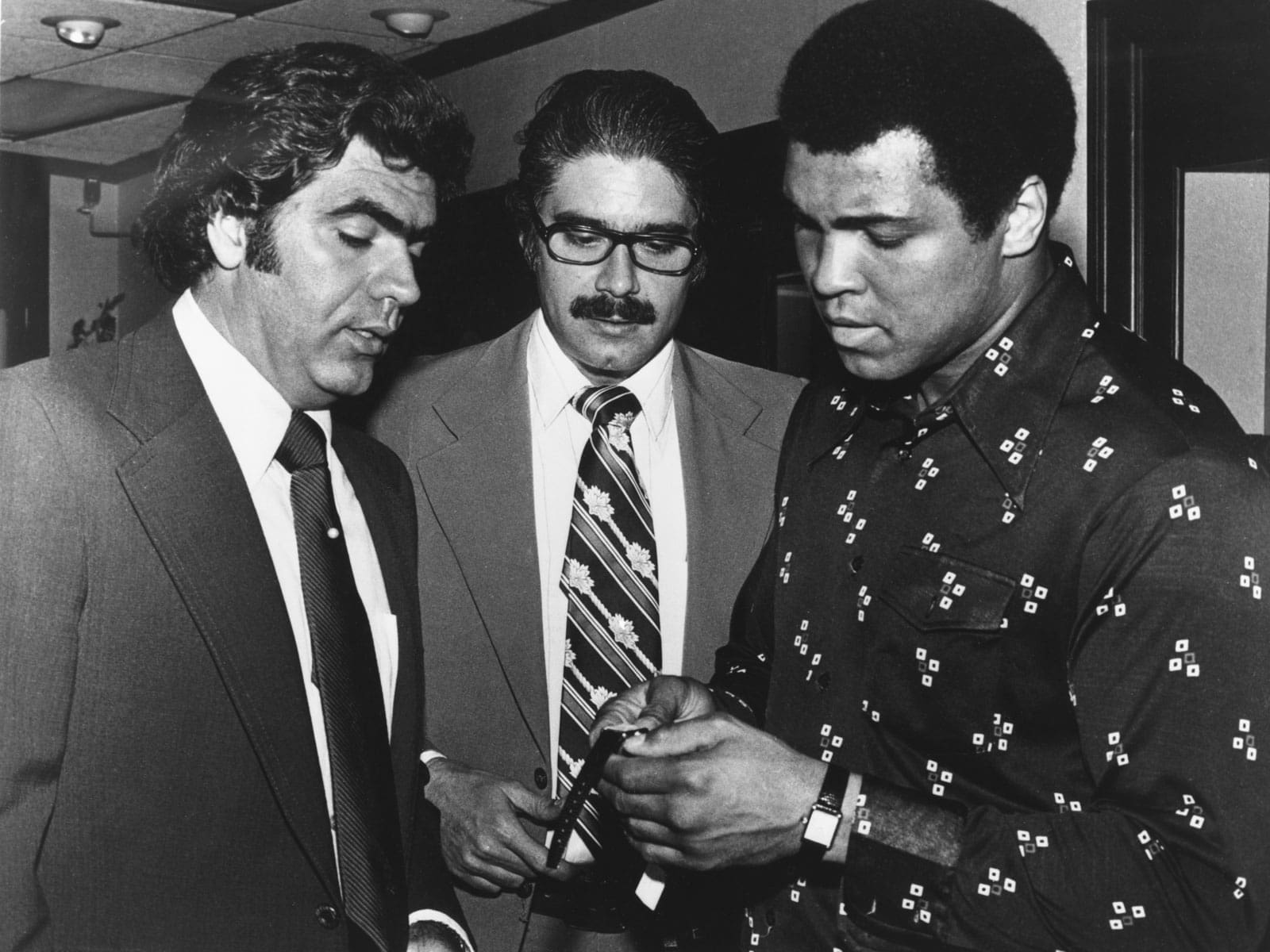Why everyone from Muhammad Ali to Andy Warhol fell for the Cartier Tank
D.C. HannayWelcome to The Icons, a series where we take a horological deep dive into the most legendary watches of all time. We’ll delve into the story behind the watch, its evolution over the years, famous (and infamous) wearers, the classic references, and the contemporary versions you should be checking out. This week it’s the Cartier Tank.
Introduction: The Cartier Tank
Talk about your icons. Ask any watch buff what the most iconic dress watch in the world is, and the answer you’ll get most often is the Cartier Tank. And apart from Rolex’s Datejust and Submariner, it’s one of the most knocked-off watches, period. Its classically proportioned rectangular case, unisex dimensions, and Roman numerals bursting forth from the dial like the opening credits of a Hollywood blockbuster have had more influence on dress watch design than almost any you can think of. To be sure, there are other blue-chip rectangular watches to consider, notably Jaeger-LeCoultre’s Reverso, but none so ubiquitous as the Tank. So how did this discreet piece of Gallic perfection reach icon status? Read on…the origin story may surprise you.
Early History
None other than Britain’s King Edward VII called Cartier “the jeweller of kings and the king of jewellers”. Louis-François Cartier’s Parisian maison had a long history of stellar design and craftsmanship, and that same artistic discipline was on display when his grandson, Louis-Joseph Cartier, designed his first wristwatch in 1904, the square-cased Santos, to address the practical needs of his friend, Brazilian pilot Alberto Santos-Dumont.
As wristwatches began to supersede pocket watches in popularity in the new century, Cartier was inspired to create new designs, and in 1917, the Tank was the result.
The rectangular shape and distinctive “brancards” (“shaft” in French) flanking the sides of the case brought a clean look to Cartier’s timepieces. The surprising source of Cartier’s design inspiration? A top-down view of the newly developed Renault FT-17 tank used on the fields of battle in WWI, with the brancards paying homage to the tank’s treads.
The new watch also featured a crown capped with a blue sapphire cabochon, blued steel hands, a railway minute track, and unsigned movements supplied by LeCoultre. One of the first recipients of the new Tank was US General John Pershing, who received a watch from Louis as a gesture of appreciation for his efforts during WWI.
Alas, production was low, scarcely climbing above 100 watches per year, and the Tank was only mildly successful. The ensuing years saw variations on the original design, including the curved Tank Cintrée, which had a case that followed the contour of the wearer’s wrist. The Tank LC (“Louis Cartier”) was a further redesign, which elongated the case but didn’t curve, and is the model that most closely hews to the iconic shape we know today as simply “the Tank”.
A somewhat less illustrious version, the Tank à Guichets covered the face with metal and featured cutout windows to show the time in a digital format.
Cartier even released a model with a reversing case, much like Jaeger-LeCoultre’s Reverso, the Tank Basculante, but time was ticking for the French firm. WWII devastated Cartier, and their foreign branches were subsequently sold off. It wasn’t until the 1960s that Cartier’s fortunes rebounded somewhat, and the slim, elegant dress watch began to show up on the wrists of luminaries including JFK, First Lady Jackie Kennedy, and boxing great Muhammad Ali. Later, less expensive gold-plate Tanks manufactured by licensees began appearing in department stores, and Cartier started to become a household name in America.
Rise To Fame
The success of the gold-plated models gave rise to the Must de Cartier line in 1976, which sported cases made of gold-plated silver, known as vermeil. The lustre of the Cartier name was somewhat restored, and the watches became “must”-have items among the fashionable set. Movie stars, musicians, and nightlife denizens at Studio 54 were the influencers of their day, setting the stage for a return to greatness. The era also saw quartz movements and coloured dials making their way into the product line, vastly increasing the reach and popularity of the Tank brand.
As the ‘70s rolled into the ‘80s, Cartier’s ownership was again in flux, and the multinational firm that eventually became known as Richemont first acquired stakes in 1988, completing the buyout of remaining shares in 1998. From that point, Cartier’s prestige was again on the rise, and the company began manufacturing movements in-house by 2005. Today’s range includes a dizzying array of models, from entry-level quartz versions (some even solar-powered), to outrageous expressions of haute horlogerie, with stratospheric prices to match.
Famous Wearers
Silent screen star Rudolph Valentino famously wore a Tank in his role in The Son Of The Sheik, obvious continuity gaffe be damned.
Despite never bothering to actually set the time, pop art godfather Andy Warhol was seldom spotted without a Tank.
Princess Diana Spencer was a big fan of the Tank, perfectly suiting her own brand of quiet elegance.
Passing from one influencer to another from a different era, Kim Kardashian owns Jackie O’s Tank, bought at auction from Christie’s in 2017 for the not-insignificant sum of $395,000.
Not that’s anything remotely effete about the Cartier Tank with everyone from Ali to Steve McQueen also falling for the watch’s square-jawed charms.
Favourite Models
With a catalogue spanning every conceivable size and price point, there are almost too many Tank models to choose from, but here are a few that warrant your attention.
The Tank Must is your entry into the world of Cartier, and this stainless extra large-cased version is the lowest-priced automatic model. It retains all the classic design cues, including the iconic case shape, blued hands, calf strap with deployant buckle, and Roman numeral dial.
The bold Tank MC sports a mesmerising blue flinqué dial, rhodium-plated handset, a matching alligator strap, and a sapphire caseback, making it easier to gawk at the automatic movement’s Geneva-striped glory.
The winsome allure of the 18k yellow gold Tank Louis Cartier, with its claret-coloured dial and strap, would look fantastic on anyone, even if Cartier classifies it as a “women’s watch”. The large case’s dimensions will suit a wide variety of wrists, and you’ll love hand-winding the movement utilising the sapphire-capped crown. Simply gorgeous.
Here’s where things get serious. Part of the Privé collection, the trapezoidal-cased Tank Asymétrique in platinum is a jaw-dropping thing of beauty, skeletonized for your viewing pleasure. The clear view of the manual-winding movement from behind is just as pretty as the view from the front of the dial. Limited to 100 pieces.
The Tank Cintrée Skeleton in platinum is an all-caps boldfaced stunner, featuring a scandalous beauty of a skeletonized in-house manual movement. One of the longest cases in the Cartier line, it curves to hug the wearer’s wrist (the movement is curved as well), and will no doubt command the attention of anyone who sees it. If you have large wrists and a healthy dose of self-confidence, this limited edition could be the perfect Tank for you.





















